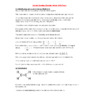|
|
Search Resources (109 Results)
 |
|
Lecture Notes | Approved: 6 years ago | 91.87 kB | Comments: 0
...Solar Energy What is it?...
...What is it? energy from the sun...
...thermal or electrical energy This energy is...
...electrical energy This energy is in the...
...most abundant renewable energy source available, and...
...Types of Solar Energy Passive Active Photovoltaic...
...in which solar energy is harnessed in...
...the active solar energy water heating system...
...uses the sun’s energy, rather than fossil...
...environmentally friendly thermal energy his energy is...
...thermal energy his energy is used to...
| N/A |
178
|
Ikonicpearl
|
 |
|
Lecture Notes | Approved: 6 years ago | 43.06 kB | Comments: 0
...interconversion of electrical energy and chemical energy....
...energy and chemical energy. There are many...
...will convert chemical energy to electrical energy...
...energy to electrical energy and allow the...
...its Gibbs free energy change, ?G. There...
...this Gibbs free energy change: ?G? =...
...in Gibbs free energy in Joules n...
...the Gibbs free energy units would work...
...the Gibbs free energy change for the...
...the Gibbs free energy change. If you...
...the Gibbs free energy is known, it...
| N/A |
143
|
Guest
|
 |
|
Lecture Notes | Approved: 6 years ago | 112.78 kB | Comments: 0
...302 for an energy diagram of this...
...all of equal energy. ?_ ?_ ?_...
...exist in allowed energy states or molecular...
...orbital of lower energy forms with most...
...is a higher energy orbital than the...
...a MO bonding energy diagram. Ex. H2...
| N/A |
126
|
Guest
|
 |
|
Lecture Notes | Approved: 6 years ago | 42.3 kB | Comments: 0
...be of sufficient energy to break the...
...determination of the energy of activation for...
...form. It takes energy to break bonds...
...break bonds and energy is released when...
...be of sufficient energy to break the...
...necessary bonds. The energy source comes from...
...from the kinetic energy of the compound...
...that the kinetic energy is temperature dependent....
...greater the kinetic energy. This energy, as...
...kinetic energy. This energy, as a function...
...function of kinetic energy and temperature is...
...is called the energy of activation. The...
...T Ea = energy of activation T...
...could calculate the energy of activation. Similarly,...
...slope embodies the energy of activation, a...
...to determine the energy of activation. One...
...what is the energy of activation for...
...cancel. Since the energy of activation is...
...is the activation energy in kJ/mol? b)...
| N/A |
115
|
Guest
|
 |
|
Solutions | Approved: 6 years ago | 73.9 kB | Comments: 0
...atoms. D) that energy is neither created...
...is converted into energy within your cells....
...following statements about energy is FALSE? A)...
...is FALSE? A) Energy can be converted...
...B) The total energy of a system...
...constant. C) Kinetic energy is the energy...
...energy is the energy associated with its...
...or composition. D) Energy is the capacity...
...lower their potential energy. Answer: C 27)...
...27) Define thermal energy. A) energy associated...
...thermal energy. A) energy associated with the...
...an object B) energy associated with the...
...an object C) energy associated with the...
...an object D) energy associated with the...
...an object E) energy associated with the...
...28) Define kinetic energy. A) energy associated...
...kinetic energy. A) energy associated with the...
...an object B) energy associated with the...
...an object C) energy associated with the...
...an object D) energy associated with the...
...an object E) energy associated with the...
...29) Define potential energy. A) energy associated...
...potential energy. A) energy associated with the...
...an object B) energy associated with the...
...an object C) energy associated with the...
...an object D) energy associated with the...
...an object E) energy associated with the...
...hydroxide. 5) Define energy. Answer: Energy is...
...Define energy. Answer: Energy is the capacity...
...the conservation of energy. Answer: Energy is...
...of energy. Answer: Energy is neither created...
| N/A |
175
|
tjeff20161982
|
 |
|
Solutions | Approved: 6 years ago | 190.22 kB | Comments: 0
...Inactive or stored energy is called __________...
...is called __________ energy. Answer: potential 7)...
...20) The universal energy compound that provides...
...that provides visible energy to cells is...
...Choice 1) Inactive energy is referred to...
...as: A) mechanical energy B) potential energy...
...energy B) potential energy C) kinetic energy...
...energy C) kinetic energy D) radiant energy...
...energy D) radiant energy E) electrical energy...
...energy E) electrical energy Answer: B 2)...
...of: A) radiant energy B) chemical energy...
...energy B) chemical energy C) electrical energy...
...energy C) electrical energy D) mechanical energy...
...energy D) mechanical energy E) potential energy...
...energy E) potential energy Answer: C 4)...
...source of stored energy in the body...
...it provides the energy needed to drive...
...needed to drive energy-absorbing chemical reactions D)...
...nucleotide E) its energy is captured in...
...is captured in high-energy hydrogen bonds Answer:...
...Inactive or stored energy is called kinetic...
...is called kinetic energy. Answer: FALSE 2)...
...FALSE 2) Stored energy is called potential...
...is called potential energy. Answer: TRUE 3)...
| N/A |
118
|
tjeff20161982
|
 |
|
Solutions | Approved: 6 years ago | 76.24 kB | Comments: 0
...A) Weight B) Energy C) Mass D)...
...following: A) Mechanical energy B) Radiant energy...
...energy B) Radiant energy C) Electrical energy...
...energy C) Electrical energy D) Chemical energy...
...energy D) Chemical energy 29) Legs moving...
...ATP are broken, energy is released to...
...cellular work. 31) Energy that travels in...
...source of stored energy. Answer: FALSE 8)...
...bond is an energy relationship between outer...
...by raising the energy of activation. Answer:...
...the release of energy B) the consumption...
...the consumption of energy C) a synthesis...
...second, and third energy levels, respectively. On...
...molecule directly provides energy for cellular work....
...potential and kinetic energy. Answer: Potential energy...
...energy. Answer: Potential energy is inactive stored...
...is inactive stored energy that has potential...
...do work. Kinetic energy is energy in...
...Kinetic energy is energy in action. 17)...
...in being the energy currency molecule? Answer:...
...molecule? Answer: Its energy is easy to...
...right amount of energy for the cell's...
...protected from excessive energy release. A universal...
...release. A universal energy currency is efficient...
...reactions that release energy cannot be reversed...
...be reversed unless energy is put back...
...Temperature increases kinetic energy and therefore the...
...enormous amount of energy to reverse. In...
...the amount of energy it takes to...
| N/A |
133
|
tjeff20161982
|
 |
|
Lecture Notes | Approved: 6 years ago | 34.6 kB | Comments: 0
...form of chemical energy. The concept of...
...and use their energy resources—is another connecting...
...most of the energy-consuming cellular work in...
...the animal exchanges energy and materials with...
...circuits that regulate energy exchange with the...
...portion of their energy from the food...
...that harvest chemical energy from the food...
...organisms require chemical energy for growth, physiological...
...Plants use light energy to build energy-rich...
...energy to build energy-rich organic molecules from...
...obtain their chemical energy in food, which...
...enzymatic hydrolysis, and energy-containing food molecules are...
...fermentation. The chemical energy of ATP powers...
...The flow of energy through an animal...
...environment as an energy consumer. Physiologists measure...
...animals use chemical energy to meet its...
...The amount of energy an animal uses...
...of all the energy-requiring biochemical reactions occurring...
...given time interval. Energy is measured in...
...all the chemical energy used in cellular...
...consumption and the energy content of food...
...account for the energy in food that...
...the animal (the energy lost in feces...
...Endothermy is a high-energy strategy that permits...
...requires much less energy than is needed...
...because of the energy cost of heating...
...the amount of energy it takes to...
...the greater the energy cost of maintaining...
...Any behavior consumes energy beyond the BMR...
...the source of energy shifts toward aerobic...
...many factors influence energy requirements. These include...
...idea of the energy costs of everyday...
...daily rate of energy consumption is 2-4...
...sedentary lifestyles. 5. Energy budgets reveal how...
...how animals use energy and materials Different...
...animals use the energy and materials in...
...size, and basic energy “strategy” of endothermy...
...the amount of energy used for BMR...
...the typical annual energy budget of four...
...a much greater energy demand per kg...
...requires much less energy per kg than...
...Further, size and energy strategy has a...
...the total annual energy expenditure is distributed...
...fraction of her energy budget for BMR...
...the mother’s annual energy requirements. Growth amounts...
...of her annual energy budget. A male...
...faction of his energy expenditures for activity...
...6% of annual energy expenditures, mainly come...
...fraction of her energy budget on temperature...
...12% of their energy budgets on reproduction....
...1/40 of the energy expended by the...
| N/A |
271
|
johaneswijaya
|
 |
|
Lecture Notes | Approved: 6 years ago | 39.7 kB | Comments: 0
...needs: Fuel (chemical energy) for all the...
...flow of food energy into and out...
...far of the energy budget of most...
...especially rich in energy, liberating about twice...
...about twice the energy liberated from an...
...be stored in energy depots. In humans,...
...muscle cells store energy as glycogen, a...
...The average human’s energy needs can be...
...occur if the energy budget remains out...
...become protein-deficient. If energy intake remains less...
...remains less than energy expenditure, death will...
...the storage of high-energy molecules during feasts...
...and to increase energy-consuming muscular activity and...
...source of chemical energy, begins in the...
...effective in obtaining energy and nutrients. People...
...an amount of energy equal to between...
...of the chemical energy contained in the...
...of the chemical energy in the diet...
| N/A |
146
|
johaneswijaya
|
 |
|
Lecture Notes | Approved: 6 years ago | 44.93 kB | Comments: 0
...Metabolism Overview: The Energy of Life Thousands...
...Cellular respiration extracts energy from sugar and...
...fuels, using the energy to perform various...
...transforms matter and energy, subject to the...
...Catabolic pathways release energy by breaking down...
...and water. The energy released by catabolic...
...biosynthetic pathways, consume energy to build complicated...
...examples of anabolism. Energy released from the...
...of anabolic pathways. Energy is fundamental to...
...an understanding of energy is key to...
...study of how energy flows through living...
...organisms. Organisms transform energy. Energy is the...
...Organisms transform energy. Energy is the capacity...
...some forms of energy can be used...
...gravity and friction. Energy exists in various...
...and cells transform energy from one type...
...to another. Kinetic energy is the energy...
...energy is the energy associated with the...
...other matter. Thermal energy is kinetic energy...
...energy is kinetic energy associated with the...
...transfer of thermal energy from one body...
...to another. The energy of light can...
...green plants. Potential energy is the energy...
...energy is the energy that matter possesses...
...a dam possesses energy because of its...
...level. Molecules possess energy because of the...
...their atoms. Chemical energy is a term...
...to the potential energy available for release...
...are formed, releasing energy and producing lower-energy...
...energy and producing lower-energy breakdown products. Energy...
...lower-energy breakdown products. Energy can be converted...
...is releasing chemical energy stored in her...
...lunch. The kinetic energy of her muscle...
...converted to potential energy as she climbs....
...dives, the potential energy is converted back...
...back to kinetic energy, which is transferred...
...enters it. Some energy is converted to...
...to friction. The energy transformations of life...
...the study of energy transformations that occur...
...to exchange either energy or matter with...
...an open system, energy and matter can...
...systems: They absorb energy—light or chemical energy...
...energy—light or chemical energy in the form...
...of thermodynamics govern energy transformations in organisms...
...states that the energy of the universe...
...universe is constant: Energy can be transferred...
...of conservation of energy. Plants do not...
...do not produce energy; they transform light...
...they transform light energy to chemical energy....
...energy to chemical energy. During every transfer...
...or transformation of energy, some energy is...
...of energy, some energy is converted to...
...which is the energy associated with the...
...warm the organism. Energy transfers and transformations...
...loss of usable energy. Entropy is a...
...thermodynamics states: Every energy transfer or transformation...
...which is the energy of random molecular...
...motion. In most energy transformations, ordered forms...
...ordered forms of energy are converted at...
...25% of the energy in gasoline to...
...organized forms of energy to heat. For...
...the form of energy input, it must...
...an input of energy, although they need...
...happen only if energy is added to...
...an input of energy, such as when...
...of matter and energy from its surroundings...
...catabolizes them to low-energy carbon dioxide and...
...Concept 8.2 The free-energy change of a...
...an input of energy? The concept of...
...concept of free energy (symbolized by the...
...a system. Free energy is the portion...
...of a system’s energy that can perform...
...change in free energy, ?G, can be...
...equivalent to total energy); ?S is the...
...the system’s free energy, and processes that...
...reactions can supply energy to do work...
...process, the free energy of a system...
...change in free energy from the start...
...loss of free energy during the change...
...has less free energy, the system in...
...release of free energy; G is negative....
...decrease in free energy, the greater the...
...686 kcal of energy are made available...
...kcal less free energy per mole than...
...that absorbs free energy from its surroundings....
...Endergonic reactions store energy in molecules; G...
...the quantity of energy required to drive...
...equivalent investment of energy. For the conversion...
...absorption of light energy. Reactions in an...
...cell releases free energy in a series...
...by the huge free-energy difference between glucose...
...top of the energy “hill” and carbon...
...source of free energy for photosynthetic organisms....
...transfer of free energy from photosynthetic organisms...
...Cells manage their energy resources to do...
...this work by energy coupling, using an...
...for mediating most energy coupling in cells,...
...ATP mediates most energy coupling in cells....
...immediate source of energy that powers cellular...
...referred to as high-energy phosphate bonds, these...
...themselves have high energy relative to the...
...relative to the energy of the products...
...The release of energy during the hydrolysis...
...of lower free energy, not from the...
...yield so much energy? Each of the...
...the cell, the energy from the hydrolysis...
...ADP. The free energy to phosphorylate ADP...
...inorganic phosphate and energy, couples the cell’s...
...couples the cell’s energy-yielding (exergonic) processes to...
...processes to the energy-consuming (endergonic) ones. A...
...an investment of energy: ADP + Pi...
...respiration, provide the energy for the endergonic...
...also use light energy to produce ATP....
...The chemical potential energy temporarily stored in...
...reactions by lowering energy barriers. Spontaneous chemical...
...molecules must absorb energy from their surroundings....
...product molecules form, energy is released as...
...shapes with lower energy. The initial investment...
...initial investment of energy for starting a...
...is the free energy of activation, or...
...activation, or activation energy (EA). Activation energy...
...energy (EA). Activation energy is the amount...
...the amount of energy necessary to push...
...reactants over an energy barrier so that...
...can begin. Activation energy is often supplied...
...form of thermal energy that the reactant...
...absorption of thermal energy accelerates the reactant...
...have absorbed enough energy for the bonds...
...graph, with the free-energy content of the...
...summit, when the energy equivalent to EA...
...loss of free energy by the molecules....
...stable bonding arrangements, energy is released to...
...decrease in free energy means that EA...
...and the thermal energy provided by room...
...provides the activation energy to energize a...
...rich in free energy. Their hydrolysis is...
...large amounts of energy. However, there is...
...is not enough energy at the temperatures...
...hump of activation energy. How are the...
...lower the activation energy and speed up...
| N/A |
140
|
johaneswijaya
|
|
Post your homework questions and get free online help from our incredible volunteers
1268 People Browsing
125 Signed Up Today
|